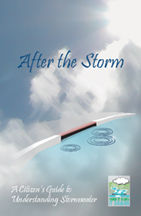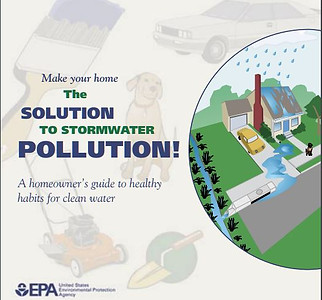Stormwater pollution from point sources and nonpoint sources is a challenging water quality problem. Unlike pollution from industry or sewage treatment facilities, which is caused by a discrete number of sources, stormwater pollution is caused by the daily activities of people everywhere. Rainwater and snowmelt run off streets, lawns, farms, and construction and industrial sites and pick up fertilizers, dirt, pesticides, oil and grease, and many other pollutants on the way to our rivers, lakes, and coastal waters.
Stormwater runoff is our most common cause of water pollution. Because stormwater pollution is caused by so many different activities, traditional regulatory controls will only go so far. Education and outreach are key components to any successful stormwater program.
10 Simple Steps That Can Have an Impact on Stormwater:
1. Don't dump ANYTHING down storm drains. Oils, chemicals, soaps, etc. pollute our streams and lakes.
2. Use pesticides and fertilizers sparingly and always follow label instructions.
3. Put litter in its place (trash cans or recycling bins).
4. Pick up after your pet.
5. Sweep driveways (don't spray wash).
6. Collect yard waste and keep it out of storm drains. Compost! Even grass clippings and excess leaves don't belong in our streams and rivers.
7. Use a commercial car wash (they treat and recycle wash water) or wash vehicles on grassy areas.
8. Recycle used motor oil.
9. Check your car for leaks (and fix them).
10. Have your septic tank inspected every 3 - 5 years.
Report an Illegal or Illicit Discharge into Storm Water
An illegal or illicit discharge is any direct or indirect non-storm water substance, pollutant, or hazardous material disposed, deposited, spilled, poured, injected, seeped, dumped, leaked, or placed by any means, intentionally or unintentionally, into storm sewers, culverts, drainage ditches, swales, creeks, rivers or any other storm water conveyance system.
Hazardous may include any substance, waste, or combination thereof, which because of its quantity, concentration, or physical, chemical, biological or infectious characteristics may cause, or significantly contribute to, a substantial present or potential hazard to human health, safety, property, or the environment when improperly treated, stored, transported, disposed of, or otherwise managed.
Pollutants may include, but are not limited to:
- Paints, varnishes, and solvents
- Oils and other automotive fluids
- Solid wastes and yard wastes
- Refuse, rubbish, garbage, litter, or other discarded or abandoned objects
- Excessive amounts of pesticides, herbicides, and fertilizers.
To report an illegal discharge contact Richard Blevins at 606-836-9661

Provides a broad overview of stormwater pollution, including runoff from residential and commercial properties, farms, construction sites, automotive facilities, forestry operations, and others. EPA 833-B-03-002


